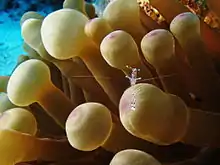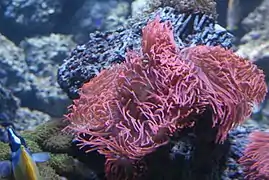Bubble-tip anemone
Bubble-tip anemone (Entacmaea quadricolor) is a species of sea anemone in the family Actiniidae.[2] Like several anemone species, E. quadricolor can support several anemonefish species, and displays two growth types based on where they live in the water column, one of which gives it the common name, due to the bulbous tips on its tentacles.
| Bubble-tip anemone | |
|---|---|
.jpg.webp) | |
| A colony of Entacmaea quadricolor. Young individuals may have about 20 tentacles, with numbers increasing during their lifetime.[1] | |
| Scientific classification | |
| Kingdom: | Animalia |
| Phylum: | Cnidaria |
| Class: | Anthozoa |
| Order: | Actiniaria |
| Family: | Actiniidae |
| Genus: | Entacmaea |
| Species: | E. quadricolor |
| Binomial name | |
| Entacmaea quadricolor (Leuckart in Rüppell & Leuckart, 1828) | |
| Synonyms | |
|
List
| |
Distribution
Entacmaea quadricolor is widespread throughout the tropical waters of the Indo-Pacific area, including the Red Sea.[3]

E. quadricolor anemones appear in a variety of morphs, including rose, orange, red, and standard green. This sea anemone can grow to be up to 30 centimetres (0.98 ft) in diameter, and obtains the majority of its energy from solar radiation via its symbiotic zooxanthellae.
A characteristic of E. quadricolor is its ability to maintain a symbiotic relationship with the anemonefish, which can be "hosted" by the anemone by providing it with defence against predators and also providing some nourishment. In turn, the anemone provides the anemonefish with shelter.
Nutrients are generally obtained by filter feeding using its sweeping tentacles, or through wastes and debris cleaned from the surface of its partner anemonefish.
In the wild, E. quadricolor are found in two locations. Large adult specimens, with tentacles that are more streaming or stringy, are often found in deeper waters with more dimly lit conditions. These specimens are often solitary, while smaller, younger specimens are often located in groups or colonies nearer to the surface, in bright sunlight. These specimens tend to show the bulbous tips on their tentacles that are characteristic of E. quadricolor. The tips of the anemones will have their characteristic bulbs based on several parameters, including; flow, light, bacterial count, color, and if its hosting. When they are placed in home aquariums, medium flow and medium lighting will be sufficient if your tank is old enough to captivate anemones.
Symbionts

E. quadricolor is found within the range of most anemonefish and is highly generalist, hosting 14 different species, around half the species of anemonefish.[4] It is thought the primary reason it does not host other species is competition, with other factors being habitat preferences or host-fish biochemical signalling.[4] The anemone fish hosted by E quadricolor are: [3]
- Amphiprion akindynos (Barrier reef anemonefish)
- A. allardi (Allard's anemonefish)
- A. barberi (Barber's anemonefish) [5]
- A. bicinctus (Two-band anemonefish)
- A. chrysopterus (Orange-fin anemonefish)
- A. clarkii (Clark's anemonefish)
- A. ephippium (Red Saddleback anemonefish)
- A. frenatus (Tomato anemonefish)
- A. mccullochi (Whitesnout anemonefish)
- A. melanopus (Red & Black anemonefish) (primarily clustered form)
- A. omanensis (Oman anemonefish)
- A. rubrocinctus (Australian anemonefish)
- A. tricinctus (Three-band anemonefish)
- Premnas biaculeatus (Maroon anemonefish) (only solitary form)
E. quadricolor also associates with juvenile Dascyllus trimaculatus and shrimps such as Periclimenes brevicarpalis.[6]
Aquaculture
In aquariums, E. quadricolor will reproduce asexually or sexually when in proper care with supplemented minerals such as iodine and other trace elements, usually purchased as an enrichment cocktail by most home aquarists. E. quadricolor is commonly kept in marine aquariums and comes in variety of colors, green and rose being the most common. Without adequate lighting, the anemone will expel its photosynthetic symbiotic zooxanthellae, a process commonly known as "bleaching" which will progressively result in its death. White or excessively translucent specimens are likely in various phases of bleaching and should not be purchased.
Anemones are not easy to keep, and require a knowledgeable aquarist. The aquarium must be at least 6 months old and stable to receive the anemone. The bigger the tank, the easier it'll be to keep a healthy anemone.[7]
 A group of individuals
A group of individuals Rose
Rose.jpg.webp) Green tipped
Green tipped Bleached (unhealthy)
Bleached (unhealthy)
References
- Scott, Anna; Harrison, Peter L. (1 June 2008). "Larval settlement and juvenile development of sea anemones that provide habitat for anemonefish". Marine Biology. Berlin / Heidelberg: Springer. 154 (5): 833–839. doi:10.1007/s00227-008-0976-1. ISSN 0025-3162.
- Daly, M. & Fautin, D. (2014). "World List of Actiniaria. Entacmaea quadricolor Leuckart in Rüppell & Leuckart, 1828". WoRMS. World Register of Marine Species. Missing or empty
|url=(help) |id=289898 |accessdate=11 March 2019 }} - Fautin, Daphne G. & Allen, Gerald R. (1997). Field Guide to Anemone Fishes and Their Host Sea Anemones. Western Australian Museum. ISBN 9780730983651. Archived from the original on 14 April 2015.
- Ollerton, Jeff; McCollin, Duncan; Fautin, Daphne G. & Allen, Gerald R. (2007). "Finding NEMO: nestedness engendered by mutualistic organization in anemonefish and their hosts". Proceedings of the Royal Society B: Biological Sciences. 274 (1609): 591–598. doi:10.1098/rspb.2006.3758. PMC 1766375. PMID 17476781.
- Allen, G.; Drew, J. & Kaufman, L. (2008). "Amphiprion barberi, a new species of anemonefish (Pomacentridae) from Fiji, Tonga, and Samoa". Aqua, International Journal of Ichthyology. 14: 105.
- Fautin, Daphne G.; Guo, Chau-Chih & Hwang, Jiang-Shiou (1995). "Costs and benefits of the symbiosis between the anemoneshrimp Periclimenes brevicarpalis and its host Entacmaea quadricolor". Marine Ecology Progress Series. 129 (1/3): 77–84. doi:10.3354/meps129077. JSTOR 24855576.
- "Bubble Tip Anemone (Entacmaea quadricolor) Care, Tank Setup, Host & Reproduction | The Aquarium Club". theaquarium.club. Retrieved 2018-08-30.
External links
| Wikimedia Commons has media related to Entacmaea quadricolor. |
| Wikispecies has information related to Entacmaea quadricolor. |
- Entacmaea quadricolor in Encyclopedia of Life
- Wiedenmann, J.; Schenk, A.; Rocker, C.; Girod, A.; Spindler, K.-D.; Nienhaus, G. U. (2002). "A far-red fluorescent protein with fast maturation and reduced oligomerization tendency from Entacmaea quadricolor (Anthozoa, Actinaria)". Proceedings of the National Academy of Sciences. 99 (18): 11646–11651. doi:10.1073/pnas.182157199. PMC 129323. PMID 12185250.